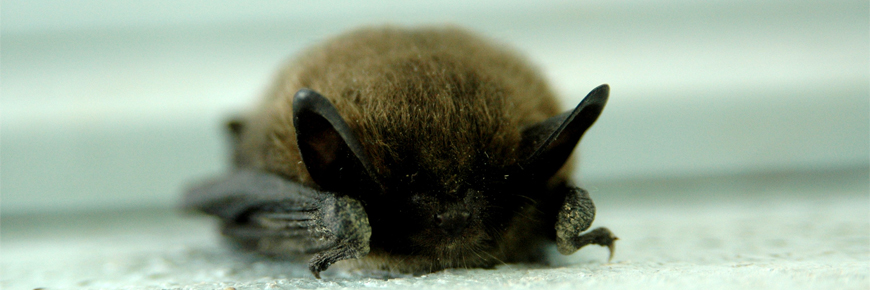
Little brown bat
Terra Nova National Park
Scientific name: Myotis lucifugus
Conservation status: Endangered
Background
The Little Brown Bat is one of three bat species native to Newfoundland and Labrador. They are pale tan to reddish or dark brown in colour with dark brown to black ears and wings. They are quite small reaching approximately 9 cm from nose to tail-tip.
The Little Brown Bat prefers forest edges by the water where they can find a diversity of prey species. In winter, they find frost-free roosts (hibernacula) in which to hibernate such as caves, mineshafts, deep rock crevasses, cellars, tunnels or unoccupied buildings.
Quick facts
- Bats are the only mammals that can fly.
- They spend a large portion of their life hanging upside-down in order to "fall into flight" which helps them escape quickly with little energy exertion.
- Little Brown Bats use what's called "aerial hawking" to catch their prey. This means they use the reflection of sound (echolocation) to help capture their prey in flight.
- Little Brown Bats can pulse their wings approximately 20 times per second when free-flying and 50 times per second when chasing prey.
Threats
Little Brown Bats face numerous threats including habitat loss, destruction of hibernacula, disturbance to hibernating bats and environmental toxins.
The most immediate and serious threat to Little Brown Bat populations is White-nose Syndrome.
White-nose syndrome is named after a fungus that spreads on a bat's skin and often causes a white fuzzy appearance on the nose, wings or ears. The fungus infects bats during their winter hibernation when their immunity and body temperature are reduced to conserve energy.
The fungus causes the bats to wake up more often and/or earlier from their hibernation. With no insects to eat, the bats quickly use their stored energy and die or emerge from their hibernating sites in poor health when spring arrives. Once the fungus appears within a hibernation site, it spreads quickly from bat to bat and can kill as much as 99% of all the individuals at a site.
Actions
The Parks Canada Agency is committed to doing its best to slow the spread of white-nose syndrome using the Canada National Parks Act and its associated regulations to provide protection for bats and their habitat throughout Parks Canada sites. Parks Canada manages park lands and historic sites that include caves, forests and even buildings that are ideal habitat for bats throughout their life cycle. The ability – and responsibility – of Parks Canada to keep these places intact and functional helps bats stay as healthy as possible and will hopefully make them more resilient to threats such as white-nose syndrome. Parks Canada Agency bat researchers collaborate with other bat experts with the goal of protecting and preserving them.
Ecologists with the Forestry and Wildlife Research Division are also monitoring bat populations at known maternal colonies and hibernacula sites, conducting regular surveillance for white-nose syndrome, collecting acoustic monitoring data, and are participating in research programs to better understand the distribution, population trends, and habitat use of bats in Newfoundland and Labrador.
Provincial ecologists take careful precautions when conducting bat research by following strict decontamination protocols and designating equipment to specific research sites.
How can the public help?
The public can help by reporting known or potential hibernation sites and dead or sick bats found on the landscape via the toll-free number (1-833-434-BATS (2287). Testing dead bats is the best means of early detection of White-nose Syndrome. It is important that people never handle bats with bare hands. People should never enter bat hibernation sites, as spores of the disease can easily be unintentionally spread by people and strict decontamination protocols are required for any contact with such sites.
It will be important to help bats that do no have white-nose Syndrome, as they will likely be crucial for allowing recovery of the species. Some ways of doing that are:
- following best management practices for bats in buildings
- contacting professionals who can safely and humanely evict bats from buildings when required
- contributing to citizen science by reporting maternal colonies on properties
- leaving dead and dying trees on the landscape (as they provide summer roosting habitat)
- preserving natural sources of fresh water (foraging habitat)
- planting native flowers to attract native insects for bats
Further information can be obtained from the Forestry and Wildlife Research Division or the toll-free bat line (1-833-434-BATS (2287). The public is also asked to keep an eye on the NL Department of Fisheries and Land Resources website for further updates.
Related links
- Date modified :